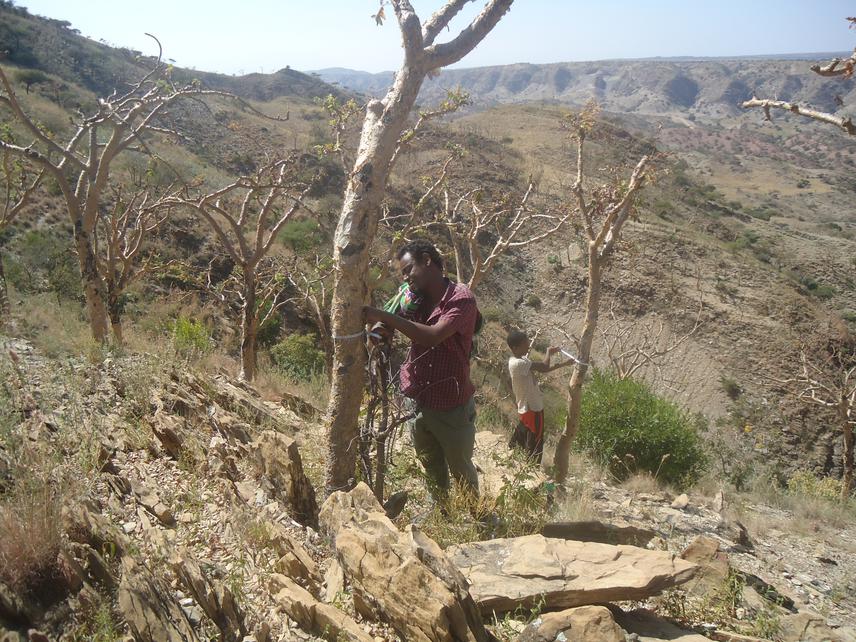Tesfay Gidey Bezabeh
Other projects
5 Sep 2018
Empowering Community to Introduce Area Enclosure for Enhancing Natural Regeneration of the Endangered Boswellia Papyrifera and its Degraded Habitat in Ethiopia
29 Jul 2020
Local Stakeholders-Based Interventions for Sustainable Conservation and Restoration of the Endangered Boswellia papyrifera and its Degraded Habitats in Ethiopia
1 Jun 2023
Local Women-Based Livelihood Interventions for Sustainable Conservation of the Endangered Boswellia papyrifera Woodlands in Ethiopia
Although Boswellia papyrifera tree species has several benefits in Ethiopia, it is currently under threatening due to different anthropogenic factors. Efforts have been made to restore it, but the efforts were unsuccessful due to lack of community involvements. This study therefore comes to prioritize the factors affecting the conservation of the tree species, and developing its community based solutions by involving all stakeholders. The project has the following aims: To prioritize the factors affecting conservation of the endangered tree species, and developing its community based solutions by involving all the stakeholders; and to train the local communities and other relevant stakeholders about the factors that affecting conservation of the tree species and their solutions in order to improve their awareness for conservation of the tree. Data for this project will be gathered using interviews, questionnaires, and focal group discussion and field observations. Final ranks of the factors and their solutions will be determined using Analytical Hierarchy Process model.

Diameter, regeneration and height measurements of Boswellia papyrifera trees species
Background of the project
Boswellia papyrifera tree species is native to Ethiopia, and primarily grown for its frankincense which is internationally traded for its various industrial uses. Although the tree has several benefits, it is currently under great threatening due to different anthropogenic factors such as uncontrolled fires, over exploitation and grazing. Due to these factors, the tree populations have decreased to ever smaller patches. Therefore, it has been listed by TRAFFIC (monitoring program of WWF and IUCN) as one of the endangered species that need conservation (Marshall, 1998). Some efforts have been made in Ethiopia to improve the populations of the tree species, however; due to lack of local community involvements these efforts were unsuccessful. This project therefore comes to fill this gap with the following species objectives:
To prioritize the factors affecting currently conservation of the Boswellia papyrifera tree by involving the local community and other relevant stakeholders
To develop community based solutions for those identified and prioritized factors that currently affecting conservation of the tree species
To train and educate the local communities, extension workers, natural resource managers and other relevant stakeholders about the factors affecting conservation of the tree species and their possible solutions in order to improve their awareness
Methods to be used
This project will be conducted in tow districts (Abergele and Kafta-Humera) of Tigray regional state of Ethiopia. The project jointly works with the local communities for prioritizing the factors affecting conservation of the tree species and their solutions. Firstly, the factors affecting conservation of tree species and their possible solutions will be gathered using interview, questionnaires, and extensive literature review and field observations. These factors will be then critically evaluated using focal group discussion in order to add, delete or amend. The well evaluated factors will then be compared each other by selected individual households using Saaty (1980) numerical scales for Analytical Hierarchy Process (AHP) model. The proposed numerical scales of the model, which goes from 1 to 9, where the value 1 implies that two factors are equally affecting conservation of the tree, and 9 indicates that from the two factors one is extremely affecting conservation of the tree.
The overall prioritization and ranks will be then determined in the model by summing of the individual ranks. The model is implemented in Expert Choice software (http://expertchoice.com) in order to facilitate is prioritization.
After preparing well prioritized factors affecting conservation of the tree species and their solutions, intensive training and education will be given to the local communities and other relevant stakeholders order to improve their awareness for conservation of the endangered tree species.
Expected outputs of the project
The awareness of the local communities, extension workers, natural resources mangers and other relevant stockholders on conservation of the endangered tree species will be improved
The factors that currently affecting conservation of the tree species and their community based solutions will be clearly identified and prioritized
Conservation and management of other endangered trees and wildlife species in the study districts will be improved as the awareness of the local communities will be enhanced